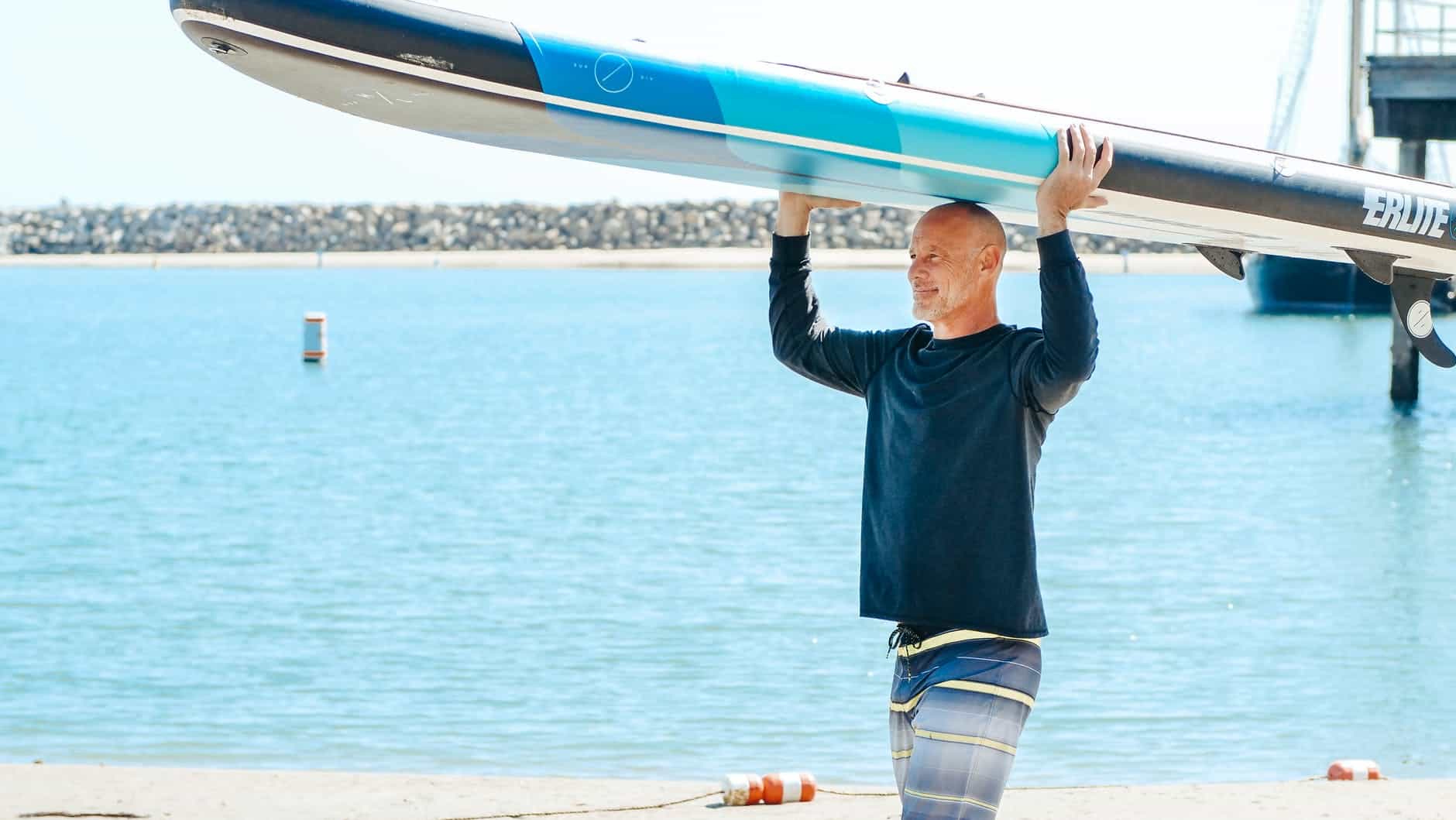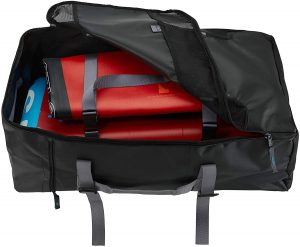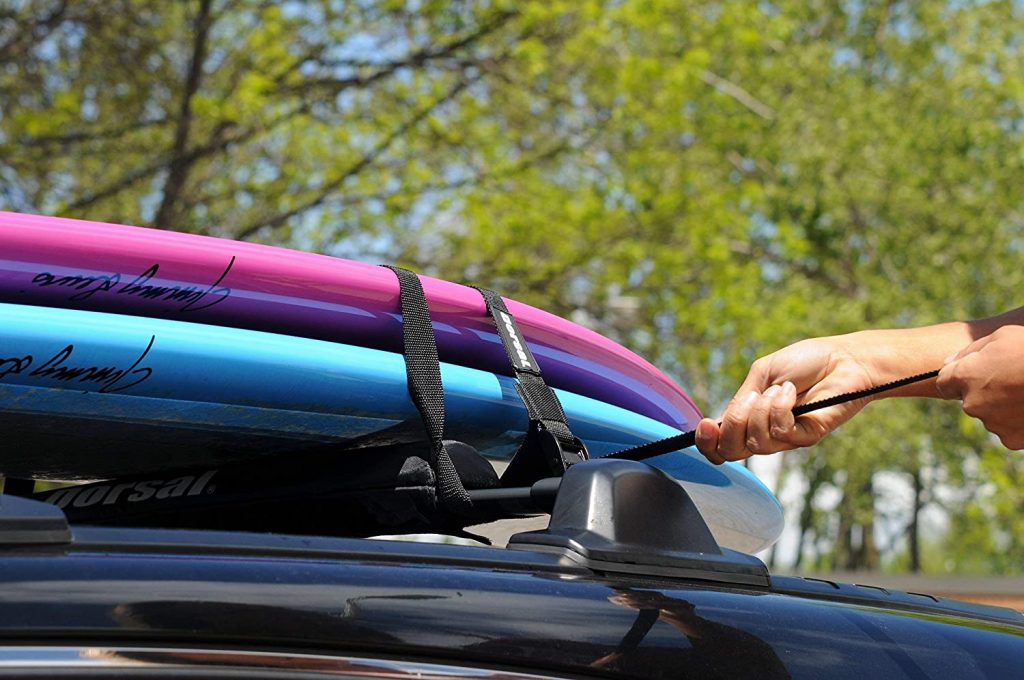Table of Contents
How To Transport and Carry a SUP Board From Your Vehicle To the Water?
Stand-up paddle boarding allows you to explore the world by water. But, unless you live next to a body of water you need to transport and carry your SUP Board (stand-up paddle board) using a vehicle.
Transporting your SUP isn’t difficult. Yet, if it’s not done properly you can cause damage to your SUP and others. We’ll teach you how to transport and carry your SUP board safely and effectively.
How to Store Your Inflatable SUP Board?
A major advantage of the inflatable SUP is its portability. Deflated SUPs are kept in a backpack and carried to the water with ease. Space isn’t a major concern as they fit in pretty much all vehicles.
But, incorrectly storing your SUP can lead to damage. You can transport your inflatable SUP on a roof rack too. But, remember it is filled with air so you could puncture it if it gets hit.
Here’s how to deflate your SUP and put it into your bag without causing it damage.
1. Remove the valve cap and push the pin into the deflate position. 2. If your board has a double chamber, repeat the first step for the inner chamber. 3. Once the air is removed, fold the board tightly from its nose to tail. 4. Ensure the final fold has the fin box on top of the other folds. 5. Use the strap or belt to secure the folded board. 6. Put your SUP into its backpack.*Note: Some models may have different deflation methods.
How to Transport and Carry a SUP Board ?
Almost all SUPs have a handle on their center. Place the board at the side of your body with its nose facing forward.
Bend your legs to grip the handle so the SUP is held under your arm. Extend your legs to help you lift the SUP off the floor without rounding your back.
Keep your arm pulled into your body to help you maintain a strong grip on the SUP. Some SUPs have a handle on the tail and nose.
If there are two of you, each grabs a handle to make it easier. If it’s too difficult to carry the SUP, you can buy a cart to help you transport it with ease.
Windy days can provide quite a challenge when it comes to carrying your SUP. Due to its length, a strong crosswind can make it difficult to hold onto.
If you are carrying a SUP on a windy day, align your board with the direction of the wind. This will prevent the board from swaying side to side.
- V2 UPDATES- We recently updated our instructions and our paddle board strap. Our instructions are much more clear and the strap is now made of all metal hardware. Please note that the strap will not...
- 100% METAL HARDWARE: When you buy an authentic SUP-Now Strap, you are buying the only paddleboard strap accessory on the market that doesn't use any plastic pieces.
- TRIPLE PADDED SHOULDER PAD: Our shoulder pad is made from soft and durable NEOPRENE for maximum comfort. The idea of these straps is to carry the weight of your board on your shoulder. We put a lot of...
- NEW From COR Surf! We've developed a paddleboard carrier that will work with ANY Sized SUP!
- LIGHTWEIGHT and COMPACT, this Stand Up Paddle Board Cart if perfect for getting your board to the beach with ease.
- The Plastic Tires don't require air so will never go flat! Rolling your paddle board will be easy.
How to Attach a SUP Board to Your Vehicle?
How you transport your SUP will depend on your vehicle. Chances are you’ll want to attach it to your roof. To attach your SUP to your vehicle you’ll need crossbars, a rack, or padding.
Crossbars are typically attached to bars that run along the roof of your vehicle. You can then attach a specific SUP rack system to the crossbars to easily keep your SUP secure. If you don’t have a SUP rack you can use some sort of padding or foam blocks.
Placing your board on your vehicle is easy with two people. Each person grabs one end then lifts it overhead before placing it on the rack.
The SUP must always be placed deck down with the fins closer to the front of the car. But, if you’re by yourself, you’ll need to take a different approach. Which approach you take will depend on the length of your vehicle.
[icon icon=”arrow-right” color=”#81d742″] How To Load Your SUP Board On Short Vehicles?
1. Lean the SUP against the side of your vehicle in a horizontal position. The deck should be facing you. 2. Grip the middle handle with one hand and the upper side of the SUP with the other. 3. Bend your legs then tilt the SUP onto your knee until it’s raised off the ground. 4. Grab the lower side of the SUP with the hand that was on the handle. 5. Extend your knees while using momentum to lift the SUP overhead. 6. From here, place the SUP on the rack.[icon icon=”arrow-right” color=”#81d742″] How To Load Your SUP Board On Long Vehicles and SUV’s ?
1. Lean the SUP against the back of your vehicle in a vertical position. The deck should be facing away from you. 2. Grip the tail of the SUP with both hands and raise it off the ground. 3. Slide the SUP up the back of your vehicle until it’s in the rack.How to Secure a SUP Board to Your Vehicle?
Specific SUP racks come with built-in straps that are easy to assemble. But, if you’re using padding or foam blocks. You’ll need to prioritize properly securing your SUP. The best way to do this is to use two cam straps.
1. Position your SUP so its widest point is between the crossbars. 2. Place the buckle of the cam strap on top of the board near its edge. 3. Throw the other end of the cam strap over the SUP. 4. Loop the end of the cam strap underneath the crossbar then throw it back over the SUP. 5. Loop the end of the cam strap underneath the crossbar again then insert it into the cam buckle. 6. Lock the cam strap into its buckle ensuring it’s tight, but not too tight. Too much tension can damage the SUP. 7. Tie the loose ends of the cam straps around the crossbars to prevent them from flying around. 8. Repeat the process with the other strap on the other crossbar.If your SUP is longer than most boards or you’re driving in windy conditions. It’s recommended you use a ratcheting bow and stern lines alongside your cam straps. They’ll help add extra security to your SUP board while driving.
1. Attach the ratchet end of the line to something secure on the tail of your SUP. If you don’t have anything secure on your SUP you can attach suction cup anchors. 2. Attach the opposite to something secure on your vehicle. This should not be a plastic part. Something like a tow hook works well. 3. Pull the end of the line to tighten it, then tie off the remaining line. 4. Repeat this process with the bowline.Conclusion
To transport and carry a SUP board to the water may not be easy the first couple of times you do it. Especially if it is your first time loading and off-loading it from your vehicle then transporting and carrying it to the water.
However once you go through some of the steps we have provided. It should get easier. Don’t forget to take advantage of carry on straps, SUP Wheel carts, and SUP roof racks to make the whole process painless.
If you have tips or techniques you use to transport and carry your sup board from your vehicle to the ocean. Please comment and let us know how you do it!
The SUP HQ ( thesuphq.com ) is a participant in the Amazon Services LLC Associates Program, an affiliate advertising program designed to provide a means for sites to earn advertising fees by advertising and linking to Amazon.com. Amazon and the Amazon logo are trademarks of Amazon.com, Inc. or its affiliates.




